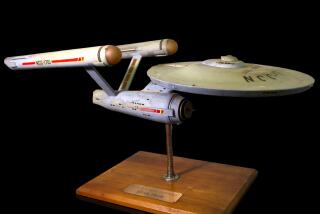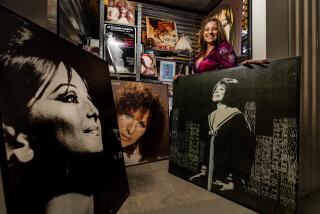Dabbling in the Quirky World of Collectibles
Marlene Daab is a woman with a passion. Taken with the television series “Star Trek,” Daab has spent the past decade collecting comic books, lunch boxes, Christmas ornaments, plates, pins, paperbacks, technical and medical journals all relating to the starship Enterprise.
She’s now got several hundred items, and the collection is growing.
“It’s an obsession,” laments the Portland, Ore.-based investor. “When you have to decide whether to buy groceries or another comic book, you know you’re in trouble.”
But Daab’s obsession has a flip side. If she ever decides to sell her collection, she knows she’ll make a profit. Already, little items that she purchased for just a few dollars some years ago are worth hundreds. Some day, she says, she may retire on the proceeds of her passion.
Daab is indicative of millions of investors who dabble in the quirky world of collectibles.
Collectible investors are unlike most others. They don’t usually get into the field simply to make money. They invest mainly for the love of whatever they’re amassing, be it historical documents, coins, stamps, baseball cards, cups, dolls, doorknobs or Ferraris.
But often, they do make money--and lots of it. That is, if they decide to sell.
Consider the investor who held onto Mickey Mantle’s rookie baseball card, which cost a few pennies in 1952. The card is now worth $40,000 if it’s in mint condition, said Ira Goldberg, president of Superior Galleries in Beverly Hills, which sells many types of collectible items, including stamps, coins, sports memorabilia and historical documents.
You could pick up a baseball signed by Joe DiMaggio for $30 three years ago, Goldberg added. Today it’s worth $300.
And a letter “of normal content” signed by Harry S. Truman that once sold for $25 is now worth $250, he said.
Even the tacky and tasteless can turn out to be extraordinary investments for those with a flair for the slightly bizarre.
Vicki Brenner started collecting “snow domes” some years back because she thought that the plastic toys were amusingly tasteless. She’s got 500 of them, and she knows that a few--including a dated dome from the 1964 World’s Fair--could be sold for many times what she paid.
But like many people who collect off-beat items, Brenner’s not in the market to sell, so she’s never bothered to price her collection.
That is, perhaps, the toughest part of investing in collectibles. The best collectors--those who could make money on the hobby--are often so tied to their investments that they can’t get themselves to sell, regardless of the price.
Nevertheless, pragmatic people can indulge in the collectibles game and earn tidy sums if they consider a few rules of the game, experts maintain. Here are a few tips from successful collect-o-philes:
* Only buy things you really like. If you’re investing in a contemporary item, it could take several years before demand for the item is strong enough to affect its price. In the interim, you should be able to enjoy it. Then, too, people who have a passion for a particular thing, regardless of whether it’s thimbles or figurines, tend to pick more sagely than those who are simply in the game for money.
* Investigate, says Goldberg. “Buy the book before you buy the item,” he advises. Collectors’ manuals are available for virtually any type of collectible. Often, if you read the manual, you know as much about the items you’re purchasing as the dealer does, he says.
If there’s no book available, there may be a magazine or newsletter. (There’s even a newsletter for snow dome investors.) It’s far cheaper to pay a few dollars for books and magazines than to learn about what you’re buying after you’ve overpaid for it, Goldberg adds.
* Specialize. It is impossible to collect every puzzle that’s ever been printed, for example. But you might be able to gather a meaningful collection of every Civil War-oriented puzzle--or of every puzzle that depicts a U.S. President. Usually, complete collections are more valuable than isolated items.
* Consider scarcity. The key to making money with collectibles is to find a one-of-a-kind--or just a few of a kind--item that is in demand. If you’re buying an item hoping it will appreciate, find out how many identical items were made and whether new ones are likely to come on the market.
Even the hottest collectible won’t appreciate if there’s an unlimited supply. However, occasionally even a relatively common item can be made more valuable if it has been signed, dated or otherwise made unique.






